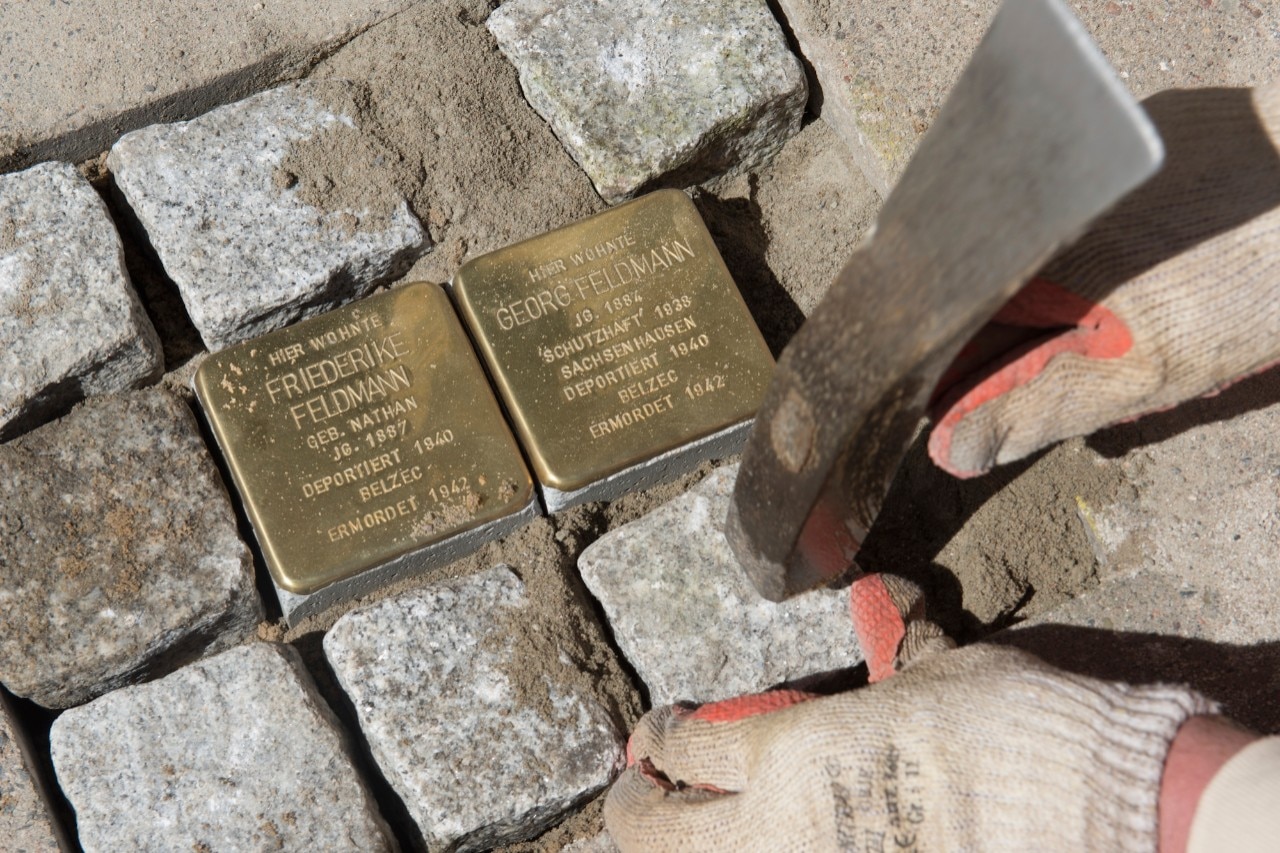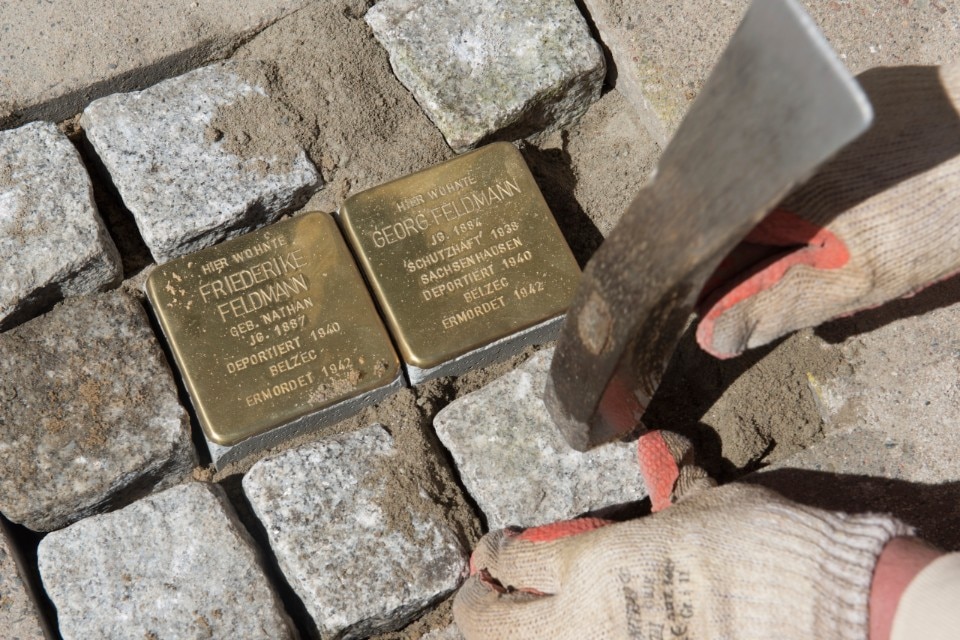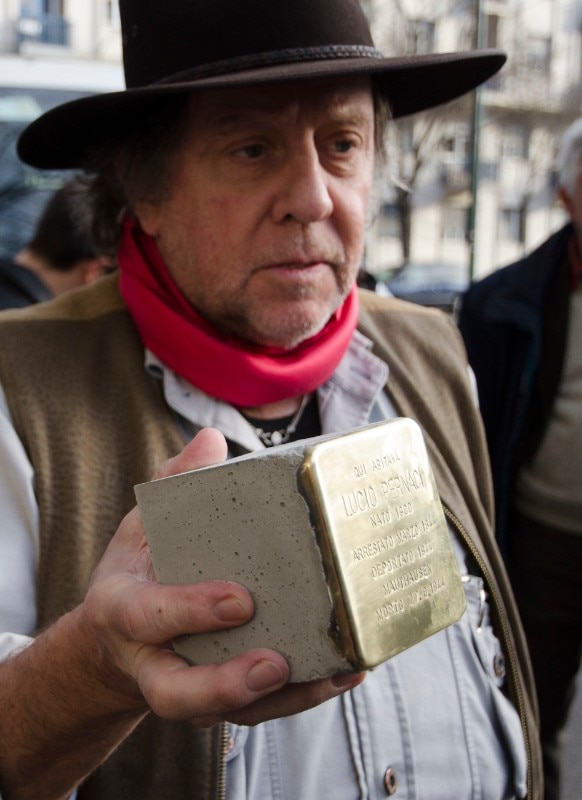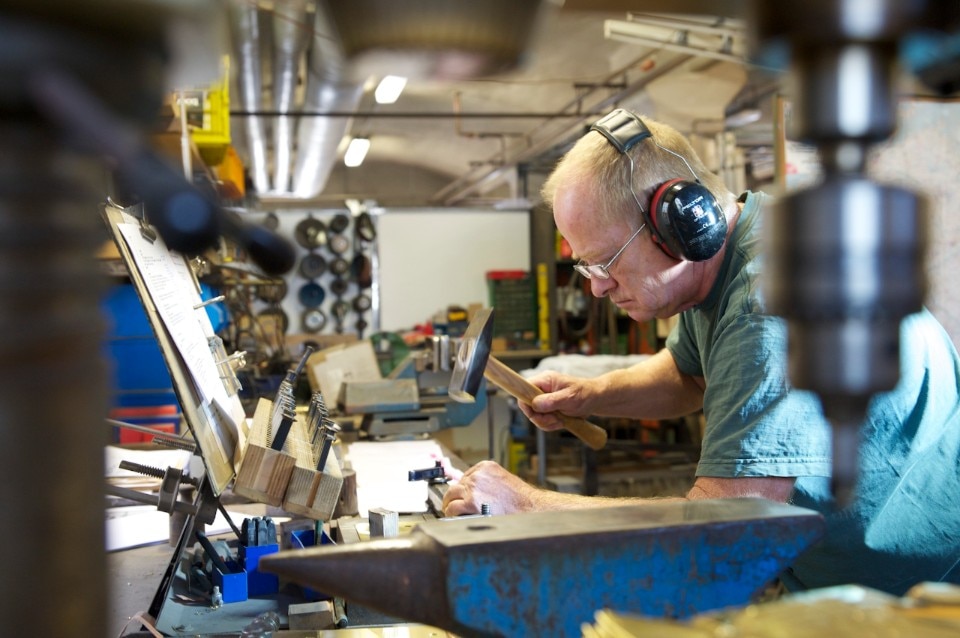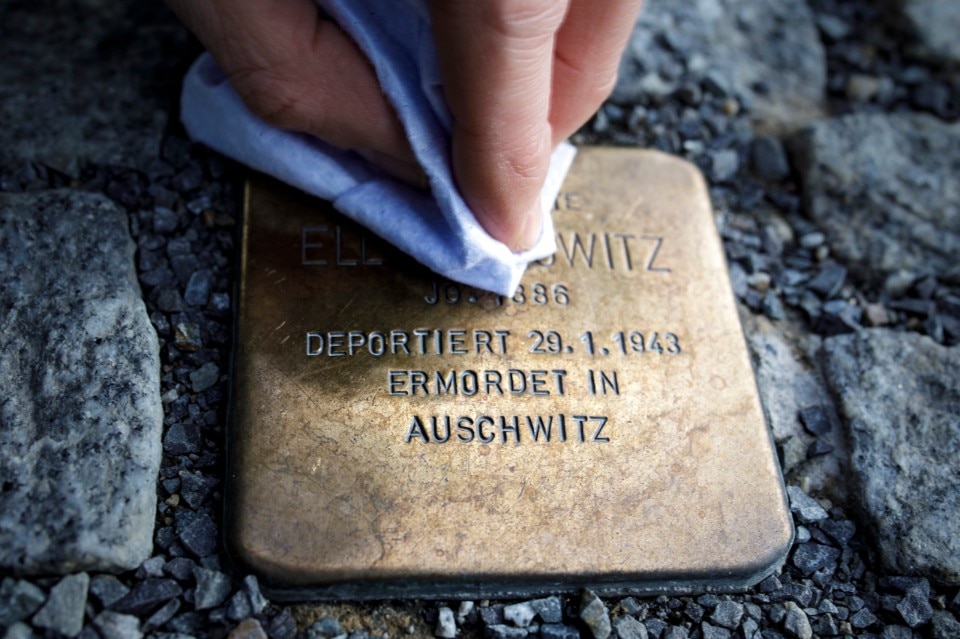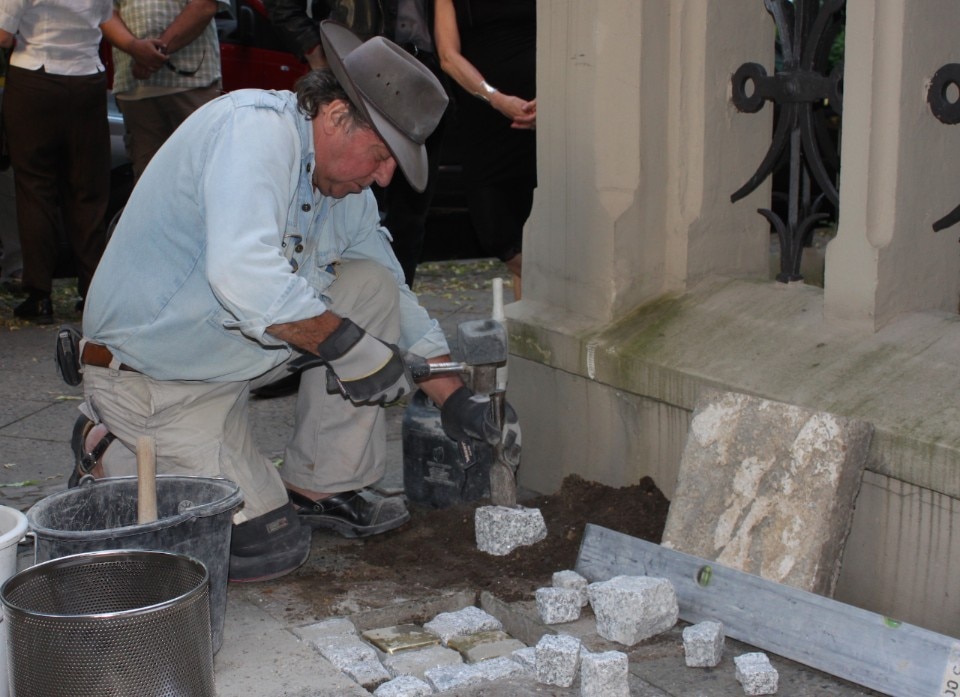This article was originally published on Domus 1049, September issue
Everyone in Germany has come across Stolpersteine at least once. These small, square brass plates, whose name literally means “stumbling stone”, are set into pavements and cobbled streets and bear the names and dates of individuals persecuted by the Nazi regime.
They commemorate human beings who were deported from their homes and murdered in concentration camps because they were Jewish, communist, homosexual or Roma, or active opponents of Hitler’s evil dictatorship, or because they were ill or mentally disabled. These were all people the regime wanted to get rid of.
The Cologne-based artist Gunter Demnig (aged 72) came up with the idea for Stolpersteine by chance more than by design. He installed the first one in the Berlin district of Kreuzberg in 1996 as part of an exhibition of artists investigating the legacy of Auschwitz. By now, Stolpersteine have become his life work. The artist has installed over 70,000 of them in 24 countries, each one in front of the last freely chosen residence of the commemorated victim. Demnig’s message is that the horrors are not rooted in Auschwitz or Buchenwald, but rather begin in our midst – with the neighbours who turned a blind eye and friends who lacked the courage to act.
This network of Stolpersteine has become the world’s largest decentralised memorial, an idea that established itself without public funds or plans drawn up by government authorities, architects or designers. This small, independent project has created a massive social network that continues to grow. In Berlin’s Hansaviertel neighbourhood and in the Hamburg district of Eppendorf, there are Stolpersteine on almost every street. Their envisioned role is to bring residents together and spark discussion. Yet sometimes they are seen as a nuisance and are protested against, vandalised and ripped from the pavement.
It can’t be the form of the Stolpersteine that attracts so much attention, for each one is inconspicuous and unpretentious, a 9.6 x 9.6 centimetre cement square onto which a square brass plate is attached.
One cannot actually stumble over them because they are installed flush with the pavement, and they aren’t made of real stone such as marble or granite. Those who choose to could easily pass them by. They do not demand attention – and their very reticence and modesty are, perhaps, the reasons why they have proven such a success. They are not crying out for attention or making a grand gesture.
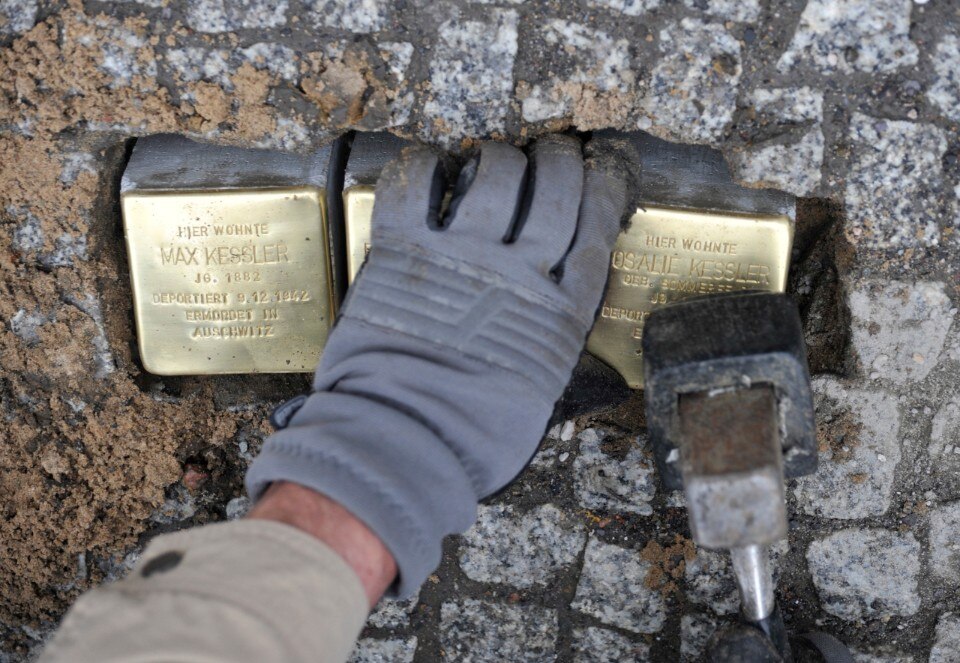
Stolpersteine are simply there, unpretentious and beautiful.Are they art? Design objects? Miniature memorials? Sculptures? Demnig has a simple answer: each Stolperstein is all of these things and much more – to wit, each one is a social sculpture.
Every engraved metal plate commemorates one single human being. At the same time, it also encapsulates the vast scale of Nazi crimes. And it represents everything such Stolpersteine evoke in survivors, both during the ceremony in which they are installed, in the preceding months and in the years after they are put into place.
Stolpersteine cannot simply be commissioned. Rather, each one requires a patron, whom Demnig envisages investigating the life of the individual the Stolperstein is intended to commemorate. Patrons need to conduct research, studying old address books and registry records, visiting archives and deciphering yellowed files and letters. They are the ones who look up dates and places and make it possible to engrave the inscription on the Stolperstein. Demnig says, “The only person who has truly been forgotten is the person whose name no one remembers.”
Associations, residential communities, school classes and private individuals can all be patrons. Not only do they come across paper records in their research, but often also the surviving descendants of the murdered individual, grandchildren and great-grandchildren. They find themselves plunged into family stories of persecution, flight and death. Friendships are formed, letters and emails exchanged. Sometimes a patron might travel to Auschwitz or Theresienstadt for the first time to visit the concentration camp and experience where the person honoured with a Stolperstein spent their final months.
Following extensive research, neighbours come together on the pavement when the Stolperstein is finally installed. Speeches are given, and songs sung. Passers-by stop and join in with the celebrations – or turn away. The patron’s experience is one no history lesson can equal. They feel grief and rage over the victim’s persecution and murder; they are joyful and touched by a sense of compassion during the installation of the Stolperstein. And they are horrified by the hatred still palpable in our society. All this is precisely what Demnig understands a social sculpture to comprise – a term he borrowed from Joseph Beuys. What happens around the Stolperstein is the work of art, not the object itself.
There have been many attempts in Germany to bear witness to the horrors of the Holocaust with memorials. Peter Eisenman’s Holocaust Memorial in Berlin is the best known. It was constructed by the German government for 27.6 million euros and is a behemoth, with 2,711 concrete slabs, known as stelae, placed over 19,000 square metres. The massive site is a magnet for tourists.
Stolpersteine are a counterexample to monumental concepts. Each one costs 120 euros; funded privately, they do not demand attention
Stolpersteine are a counterexample to such monumental concepts. Each one costs 120 euros and they are funded privately. The objects do not demand attention but take their place humbly among the cobblestones. Those uninterested in grappling with difficult memories simply keep walking. Yet many passers-by find themselves pausing exactly because the Stolpersteine are so small and unspectacular – and find themselves peering down to read the inscription.
They might make out a dedication stating: “Last home of Elisabeth Pick, née Bäumel, born 1889, deported 2.3.1943, murdered in Auschwitz.” This terse, dry text contains so much. Who was this woman? What suffering was she subjected to in and on her way to Auschwitz? Did she have any friends? Why couldn’t anyone help her? And before they know it, they are immersed in the unfathomable horrors of the Nazi era. Or they might stumble across the 11 Stolpersteine for Käthe and Dr. Nachman Schlesinger and their 9 children. An entire family of 11 all murdered in Auschwitz on the same day. Their youngest child was only 8 years old. The horror is inconceivable. The physical form of the commemorative stone essentially becomes invisible, receding in the face of the contents, which are so overwhelming, so infinitely horrific.
The project has taken on a life of its own because it is so effective. Much like an avalanche, it has gathered momentum, with more and more people inquiring about sponsoring Stolpersteine.
Waiting lists grow ever longer, and it can take two years before one’s turn comes around. Berlin has over 8,600 Stolpersteine, while Hamburg has about 5,700. Only a few places in Germany have not joined the project. Munich is one, due to Jewish community centre president Charlotte Knobloch, who did not want people to step on memorials to those murdered. This is why Munich decided to install 1.86-metre-high stelae made of stainless steel instead of Stolpersteine after a debate lasting many years. These are bulky and impractical – a decision many have questioned the wisdom of.
Unfortunately, the popularity of Stolpersteine has also given rise to a sense of mistrust and weariness.
Can this successful project continue indefinitely? Is it possible to have too many Stolpersteine, so that an individual marker fails to attract the attention it deserves? Did it make sense when Demnig decided to install Stolpersteine not only for those murdered but also for those persecuted who survived the Holocaust? What will happen when Demnig is no longer able to travel? Until now he has attempted to install each Stolperstein personally.
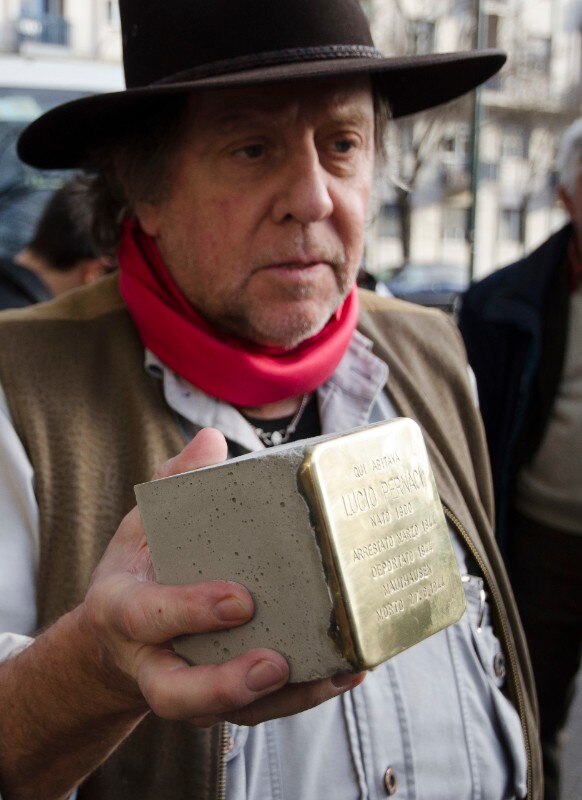
In 2018, Wolfgang Gedeon, member of the Baden-Württemberg state parliament for the farright Alternative for Germany (AfD) party, called for an end to Stolpersteine. He spoke of a “dictatorship of remembrance”, of the “inflation” of commemoration, and of the patrons as “obtrusive moralists”. But criticism comes from other quarters as well. Some Holocaust victims and their families are afraid that German patrons are seeking to absolve themselves of guilt by placing Stolpersteine in front of their buildings. People who have sponsored Stolpersteine often regard themselves as being better people and above moral reproach. This is also the reason behind the many cleaning campaigns, most of which take place around significant historical dates such as the pogrom night between 8 and of 9 November.
People kneel on the pavements and polish the tarnished brass plates until they shine once more, lighting candles and placing flowers beside them. It is true that Stolpersteine can assuage a sense of guilt by simplifying a complex system of persecution into a straightforward chain of events.
Since their introduction almost 25 years ago, Stolpersteine have become a firm fixture in German culture, and it is impossible to imagine their absence. They were wholly novel in 1996, a humble and therefore highly effective form of commemoration. The man behind them never wanted to be a designer. Yet without intending to, he has succeeded in creating what every designer dreams of: he has made an instantly recognisable and utterly unique object, modest, useful, straightforward and unfussy, accessible to all free of charge. Admittedly, this object isn’t utilitarian in the usual sense: all one can do is regard it and consider it. Yet it has played a significant societal role. For every Stolpersteine represents an individual fate, and each individual fate represents the inconceivable crime of the Holocaust, impossible to apprehend in its entirety. Demnig has come up with an unparalleled concept.
Anja Lösel has worked as an editor at Art and Stern, where she wrote about art, architecture and design. She is writing a book about her own experiences as a Stolpersteine patron. She lives in Berlin.
Gunter Demnig (Berlin, 1947), artist, studied Art and Industrial design in Berlin. He opened a studio in Cologne in 1985 and launched the stumbling stone (Stolpersteine) project in 1993.


